Automotive Part Casting: The Backbone of Modern Car Manufacturing
2025-02-06
The automotive industry has come a long way since the early days of vehicle production. Today, the complexity and performance demands of modern cars require advanced manufacturing techniques, and one such method that plays a critical role is automotive part casting. This process is responsible for creating some of the most essential components in a vehicle, from engine blocks to transmission cases and suspension parts. In this blog, we will explore the significance of automotive part casting, its processes, and the benefits it offers to the automotive manufacturing world.
What is Automotive Part Casting?
Automotive part casting is a manufacturing process that involves pouring molten metal into a mold to create a specific shape or part. The metal cools and solidifies within the mold, taking on its shape to form a precise component that can be used in a car. Casting is often used for parts that need to be strong, durable, and able to withstand high temperatures and pressures.
Common materials used in automotive part casting include aluminum, iron, steel, and magnesium. Each material is chosen based on its properties, such as strength, weight, and resistance to wear and corrosion, which are essential for the part's intended function.
Types of Automotive Casting Processes
There are several types of casting processes used in the automotive industry, each suited for different applications:
1. Sand Casting: Sand casting is one of the oldest and most widely used methods for automotive part casting. It involves creating a mold from fine sand and then pouring molten metal into it. This process is relatively inexpensive and ideal for producing medium to large quantities of parts. It is commonly used for components like engine blocks, cylinder heads, and transmission cases.
2. Die Casting: In die casting, molten metal is injected into a steel mold under high pressure. This method is known for producing parts with intricate details and smooth surfaces. Die casting is used for making parts such as valve covers, pistons, and various engine components. It is particularly useful for producing parts in large volumes with high dimensional accuracy.
3. Investment Casting: Investment casting, also known as lost-wax casting, involves creating a wax model of the part, coating it with a ceramic shell, and then melting the wax to leave a hollow mold. Molten metal is poured into the mold to create the final part. This process is often used for smaller, more complex parts that require a high level of precision, such as turbine blades or specific engine components.
4. Permanent Mold Casting: This process uses a reusable mold made of metal to pour molten metal into. It is often used for high-volume production of parts that need to be durable, such as automotive wheels and engine components. The reusable mold ensures consistency and improves production efficiency.
Advantages of Automotive Part Casting
1. Cost-Effective Production: Casting is often more economical than other manufacturing methods, especially for producing large quantities of parts. Once the mold is created, it can be used repeatedly, which reduces production costs over time. This makes casting ideal for mass production of automotive parts.
2. Complex Geometries and Precision: Casting allows for the production of parts with complex shapes and intricate details that may be difficult or impossible to achieve with traditional machining. This is particularly important in the automotive industry, where parts need to meet strict design and performance specifications.
3. Material Efficiency: The casting process produces minimal waste, as the molten metal fills the mold to create the desired part. Additionally, the process allows for the use of materials that would otherwise be difficult to shape or form, such as certain alloys or metals with high melting points.
4. Durability and Strength: Automotive parts made through casting, especially those made from aluminum or iron, are highly durable and can withstand the stresses and high temperatures often found in vehicle engines, transmissions, and other systems. The casting process results in components with excellent mechanical properties and resistance to wear and tear.
5. Design Flexibility: Casting provides designers with greater flexibility in creating custom parts. Because molds can be designed to accommodate various shapes and features, automotive manufacturers can produce components with specific needs in mind, such as lightweight or high-strength parts.
Challenges in Automotive Part Casting
While automotive part casting offers numerous benefits, there are also challenges associated with the process:
1. Tooling Costs: Creating the molds required for casting can be expensive, especially for complex parts. The initial investment in tooling can be high, which may not be cost-effective for small production runs.
2. Material Limitations: While casting allows for a wide variety of metals to be used, not all materials are suitable for every part. For example, some materials may have limitations in terms of strength or durability, requiring manufacturers to carefully select the appropriate material for each part.
3. Porosity and Defects: Casting can sometimes result in parts with defects, such as air bubbles or voids within the metal. These imperfections can affect the strength and performance of the part, requiring additional steps such as inspection, rework, or scrap.
4. Cycle Time: The casting process can be time-consuming, especially for larger parts or those requiring intricate molds. This can lead to longer lead times for production, which may be a challenge for manufacturers working on tight deadlines.
Conclusion
Automotive part casting is a crucial element of the modern car manufacturing process. Its ability to produce strong, precise, and cost-effective components has made it an essential method in the automotive industry. Despite some challenges, the advantages of casting—such as its versatility, durability, and ability to create complex parts—make it a preferred method for producing a wide range of automotive components. As the demand for high-performance vehicles continues to rise, the role of automotive part casting will remain vital in ensuring that these vehicles are built with the highest standards of quality and precision.



